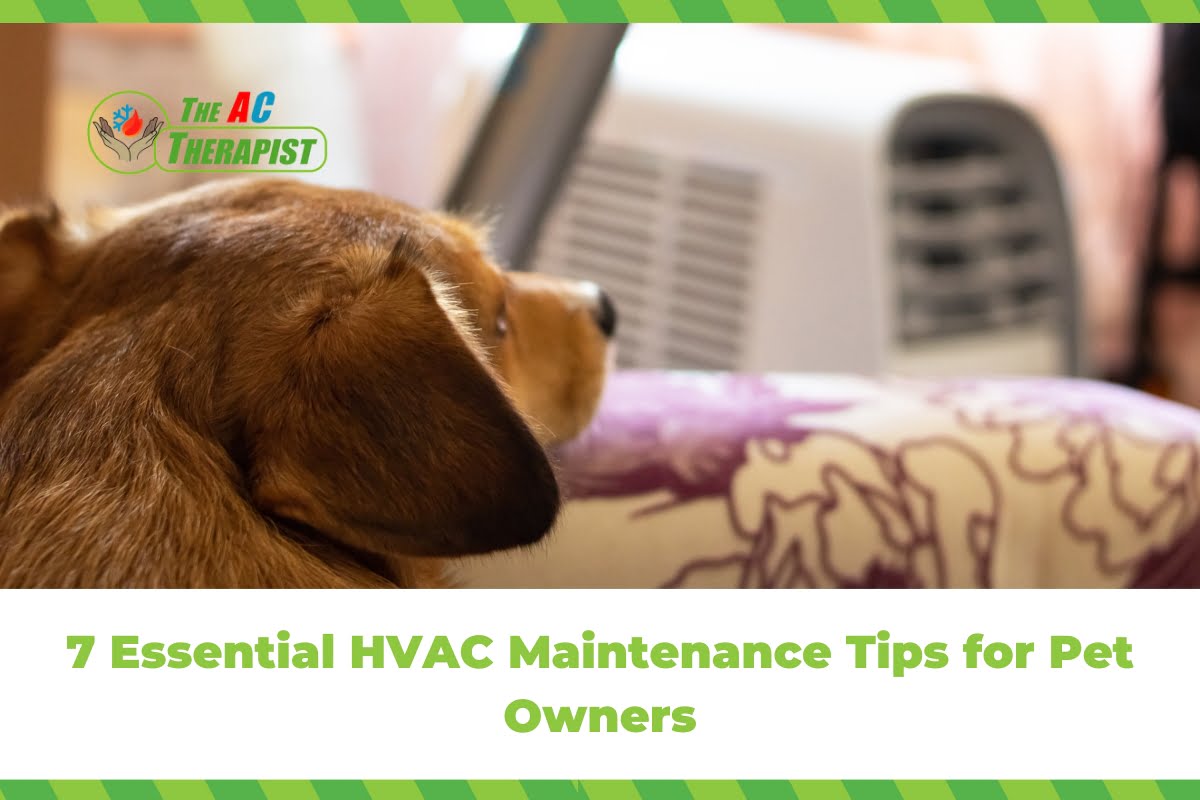7 Essential HVAC Maintenance Tips for Pet Owners
Hello, dear readers and loyal customers! We at The AC Therapist understand that your pets are more than just animals; they’re part of your family. As your trusted HVAC contractor in the Tampa Bay area, we know how vital it is to maintain a home environment that’s comfortable for every family member, including the four-legged ones. That’s why we’ve prepared this detailed guide to HVAC maintenance specifically designed for pet owners. Let’s get into it!
Why Is HVAC Maintenance Essential for Pet Owners?
HVAC maintenance is especially crucial for pet owners for several key reasons:
Improved Air Quality
Pets shed fur and skin cells (dander), which can circulate through your HVAC system and compromise indoor air quality. Regular maintenance, such as frequent filter changes, can help capture these particles, making the air safer for both you and your pets.
Enhanced System Efficiency
Fur and dander can also clog your HVAC filters, which forces the system to work harder to circulate air. This can lead to increased energy costs and reduce the lifespan of your system. Regular maintenance can help prevent this inefficiency.
Odor Control
Pets often bring unique smells into a home, some of which are less than pleasant. A well-maintained HVAC system, possibly equipped with air purifiers or UV lights, can help mitigate these odors.
Comfort for Pets
Just like humans, pets feel the effects of temperature and humidity. A well-maintained HVAC system provides a more consistent climate, which is better for your pets’ comfort and overall health.
Preventive Health
Poor air quality can exacerbate allergies and respiratory issues in pets just as it can in humans. By maintaining your HVAC system, you reduce the risk of such health problems.
Lower Repair Costs
A well-maintained system is less likely to break down, saving you from emergency repair costs, which could be higher if the system has to deal with the added strain of pet hair and dander.
Stress Reduction
Unusual noises or inconsistent temperatures from a failing HVAC system can stress pets. Regular maintenance can ensure a quieter, more consistent operation, thus reducing potential stress triggers for your pets.
By paying close attention to your HVAC system’s needs, you’re also investing in the well-being of your pets. Regular HVAC maintenance is a win-win situation for everyone in the household.
Tip #1: Replace or Clean Your Filters Regularly
The presence of pets usually means that you’ll need to replace or clean your filters more often. Pet hair and dander can clog filters, reducing airflow and system efficiency. A clogged filter can also spread allergens around your home, affecting your pets. Opt for HEPA filters, which are designed to trap smaller particles, including pet dander.
One of the most straightforward yet crucial aspects of HVAC maintenance, particularly for pet owners, is the regular replacement or cleaning of air filters. Here’s why this is so important and how you can effectively do it:
Why It’s Important:
- Improved Air Quality: A clean filter captures pet dander, fur, and other pollutants more effectively, leading to better indoor air quality.
- Enhanced Efficiency: Clogged filters make your HVAC system work harder to push air through, resulting in higher energy bills and increased wear and tear on the system.
- Longer System Lifespan: Regular filter changes can prolong the life of your HVAC system by reducing the strain on its components.
Steps to Replace or Clean Your Filters:
- Identify Filter Location: Filters are commonly found in the return air duct or blower compartment before the return air reaches the air handler.
- Check Filter Type: Your HVAC system might use disposable filters or washable filters. Know which type you have to proceed appropriately.
- Frequency: For homes with pets, it’s generally a good idea to check your filter once a month. You might need to replace it monthly or every two to three months, depending on how clogged it gets.
- Removal and Inspection: Turn off your HVAC system for safety, then carefully remove the filter for inspection. If it’s visibly dirty or clogged, it’s time for a change or a clean.
- Cleaning or Replacement: If you have a washable filter, clean it according to the manufacturer’s guidelines. If it’s disposable, replace it with a new one, ensuring it fits snugly.
- Proper Disposal: Dispose of old disposable filters in accordance with local regulations.
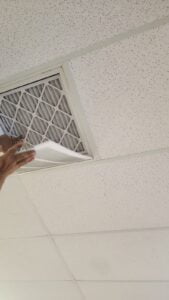
Tip #2: Keep Vents Unobstructed
Pets love to find cozy spots, and that sometimes means they’ll curl up near or on top of vents. Not only is this bad for your pet’s health due to the fluctuating temperatures, but it can also reduce the efficiency of your HVAC system.
Why It’s Important:
- Efficient Airflow: Obstructed vents can restrict airflow, causing your HVAC system to work harder to maintain the desired temperature, which leads to higher energy costs.
- Consistent Temperatures: Blocked vents can create hot or cold spots in your home, affecting the comfort of your family and pets.
- Safety: Pets often seek warm or cool places to relax. However, sitting near or on a vent can be hazardous, especially if it leads to overheating or cooling issues.
Steps to Keep Vents Unobstructed:
- Identify Vent Locations: Walk through your home to locate all air vents and make sure they are easily accessible.
- Remove Obstructions: Clear away any furniture, pet beds, or toys that might be blocking the vents.
- Vent Grilles: Consider installing vent grilles or covers that allow for better airflow while also preventing pets from sitting directly on top of the vents.
- Regular Inspection: Make it a habit to check vents regularly, especially during seasonal transitions when you may rearrange furniture or bring in new items that could block airflow.
- Cleaning: While you’re at it, use this opportunity to clean the vent grilles as pet hair and dander can often accumulate here, further obstructing airflow.
Tip #3: Regular Duct Cleaning
The ducts in your HVAC system can collect pet hair, dander, and other pollutants. This can result in bad odors and reduced air quality. Duct cleaning removes these accumulations, thus improving the air quality and ensuring more efficient operation.
Duct cleaning is often an overlooked aspect of HVAC maintenance, but it is especially crucial for homes with pets. Here’s why this service is necessary and how to go about it:
Why It’s Important:
- Improved Air Quality: Over time, pet hair, dander, and other contaminants can accumulate in the ductwork, affecting the air quality in your home. Regular cleaning removes these pollutants.
- Enhanced Efficiency: Clogged or dirty ducts restrict airflow, making your system work harder to maintain temperatures. Clean ducts improve overall efficiency.
- Odor Elimination: Pet smells can become trapped in the ductwork and circulate through the home. Cleaning the ducts can help to eliminate these odors.
Steps for Duct Cleaning:
- Inspection: The first step in duct cleaning is an inspection to assess the level of contamination. This often involves a camera survey of the inside of the ducts.
- Cleaning: The actual cleaning can involve several techniques, including brushing, air sweeping, and vacuuming, often performed using specialized equipment.
- Sanitization: After cleaning, it’s a good idea to sanitize the ducts to eliminate any lingering bacteria or mold spores.
- Filter Replacement: Always pair duct cleaning with a new filter to ensure that you are not immediately contaminating your newly cleaned ducts.
- Frequency: The frequency of duct cleaning can vary, but homes with pets should consider having this service performed at least once a year.
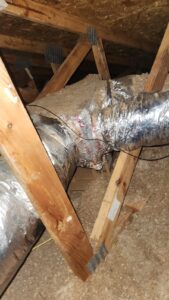
Tip #4: Install Air Purifiers
While your HVAC system can filter out many pollutants, an air purifier can provide an extra layer of protection. Air purifiers can remove odors and harmful particles, making the air easier to breathe for both humans and pets.
For pet owners who are looking to go the extra mile to ensure optimal air quality and HVAC efficiency, installing air purifiers can be an excellent investment. Here’s what you need to know:
Why It’s Important:
- Exceptional Air Quality: Air purifiers can capture particles as small as 0.3 microns, including pet dander, dust, and pollen, providing an extra layer of air purification in addition to your HVAC system.
- Odor Control: Many air purifiers come with activated carbon filters that can absorb pet odors, keeping your home smelling fresh.
- Health Benefits: Improved air quality is beneficial for everyone in the household, including pets, who are often more sensitive to pollutants and allergens.
Steps for Installing Air Purifiers:
- Assess Your Needs: Determine the size of the area you want to purify and consider the specific concerns you have, such as allergies, pet dander, or odors.
- Choose the Right Type: There are various types of air purifiers, including HEPA filters, activated carbon filters, and UV purifiers. Each has its advantages and drawbacks, so choose one that suits your needs best.
- Placement: For maximum effectiveness, place air purifiers in areas where your pets spend most of their time. However, avoid placing them too close to walls or furniture, which can obstruct airflow.
- Regular Maintenance: Just like any other part of your HVAC system, air purifiers require regular cleaning or filter replacements to function efficiently.
Tip #5: UV Lights for Improved Air Quality
Installing UV lights in your HVAC system can kill bacteria, mold, and other harmful pathogens. These lights can be especially useful in homes with pets to improve air quality.
Utilizing UV lights in your HVAC system is a state-of-the-art approach to improving air quality, and it’s particularly beneficial for households with pets. Here’s what you need to know about this technology:
Why It’s Important:
- Germs and Odor Control: UV lights are known for their ability to kill bacteria, viruses, and mold. They can also help neutralize pet odors that may be lingering in the air.
- Improved Air Quality: UV lights can break down harmful volatile organic compounds (VOCs), which can contribute to respiratory issues for both humans and pets.
- Enhanced HVAC Efficiency: A cleaner, germ-free HVAC system runs more efficiently, saving you money on energy bills in the long run.
Steps for Installing UV Lights:
- Consult a Professional: This is not a DIY job. Consult professionals to ensure that the UV light is correctly installed in your HVAC system for optimal results.
- Choose the Right Type: There are several types of HVAC UV lights, including coil sterilization and air sterilization lights. Discuss with your HVAC professional which type would best suit your needs.
- Placement: UV lights are generally installed near the HVAC coils or in the ductwork. Proper placement is crucial for their effectiveness.
- Maintenance: While UV lights have a longer lifespan compared to standard light bulbs, they do require replacement typically every 1-2 years.
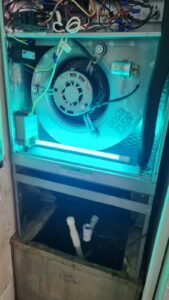
Tip #6: Maintain Consistent Temperatures
Drastic changes in temperature can be stressful for pets, especially older ones. A well-maintained HVAC system ensures that your home’s temperature stays consistent, which is better for your pet’s health.
Maintaining a consistent temperature in your home is not only crucial for your comfort but also for the well-being of your pets. Let’s delve into why this is vital and how to go about it:
Why It’s Important:
- Pet Comfort: Pets, especially small ones or those with thin coats, are sensitive to extreme temperature changes. A consistent temperature keeps them comfortable year-round.
- Energy Efficiency: When your HVAC system maintains a consistent temperature, it operates more efficiently, saving you money on your energy bills.
- Prevent Health Issues: Rapid temperature fluctuations can contribute to respiratory issues and other health concerns for pets, like overheating or hypothermia.
Steps to Maintain Consistent Temperatures:
- Programmable Thermostats: Installing a programmable or smart thermostat allows you to set temperatures for different times of the day, ensuring consistency.
- Regular HVAC Check-ups: Routine maintenance checks ensure your HVAC system is functioning optimally. Any minor issues can be addressed before they affect temperature control.
- Use Fans Wisely: Fans can help distribute air more evenly throughout your home, but remember that fans cool people (and pets), not rooms. Turn them off when not needed.
- Seal Leaks: Check for drafts in windows, doors, and ducts. These can cause temperature fluctuations and make your HVAC system work harder.
- Zoning Systems: Consider installing an HVAC zoning system to maintain different temperatures in various parts of your home, beneficial if your pets stay in particular areas.
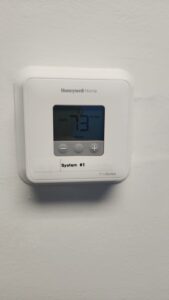
Tip #7: Schedule Regular Professional Maintenance
Annual professional maintenance ensures that your HVAC system is working efficiently and minimizes the risk of breakdowns. This is even more crucial for pet owners due to the additional strain pets can put on the system.
Regular professional maintenance is the backbone of any well-functioning HVAC system, but it’s even more critical for pet owners. Here’s why scheduling regular checks is a must:
Why It’s Important:
- Longevity: Regular maintenance extends the life of your HVAC system, saving you money in the long run.
- Efficiency: A well-maintained system runs more efficiently, reducing energy bills and environmental impact.
- Preventive Care: Routine checks can identify minor issues before they become major problems, avoiding unexpected breakdowns.
Steps to Schedule Regular Maintenance:
- Find a Reliable Service Provider: The quality of your maintenance service is as important as the frequency. Make sure you work with certified professionals.
- Seasonal Checks: Schedule professional maintenance at least twice a year—once before summer and once before winter—to prepare your system for heavy usage.
- Sign Up for a Maintenance Plan: Consider signing up for a maintenance plan that offers regular check-ups, discounts, and other benefits.
- Keep Records: Keep a log of all maintenance activities. This can be useful for warranty claims and for tracking the performance of your HVAC system over time.
Our Therapy Maintenance Plans are designed to help you keep your HVAC system in tip-top shape, which directly contributes to maintaining consistent temperatures. With regular check-ups, we can ensure your system is optimized for both efficiency and comfort.
By focusing on keeping a consistent temperature in your home, you make it more comfortable and healthier for everyone, including your pets. It’s a straightforward way to improve the quality of life for your entire household while also reaping the benefits of a more efficient HVAC system.
Keep Your Furry Friends Safe and Your System Efficient!
Your HVAC system doesn’t just provide comfort to you; it’s also a vital part of your pet’s well-being. Neglecting HVAC maintenance when you have pets can result in poor air quality, uncomfortable living conditions, and even health concerns for your furry family members. From replacing filters regularly to installing UV lights and scheduling professional maintenance, there are multiple steps you can take to ensure both your HVAC system and pets thrive.
At The AC Therapist, we are committed to your home’s overall health and comfort. Our various Therapy Maintenance Plans are specifically designed to offer you peace of mind and provide the best environment for you and your pets. Each plan includes an array of services such as regular check-ups, duct sanitation, and even UV light installation, depending on the tier you choose.
Don’t compromise on comfort or health when both can effortlessly co-exist. Invest in regular HVAC maintenance today for a happier, healthier tomorrow for you and your pets.
As a company that offers comprehensive HVAC services, from AC repair to duct cleaning and beyond, The AC Therapist is committed to making your home a sanctuary for every family member. By following these maintenance tips, you’ll not only prolong the life of your HVAC system but also create a healthier, more comfortable home for your beloved pets.
Contact us today to learn more about our Therapy Maintenance Plans and other services designed to improve your home’s air quality and HVAC efficiency. Your furry family members will thank you!

